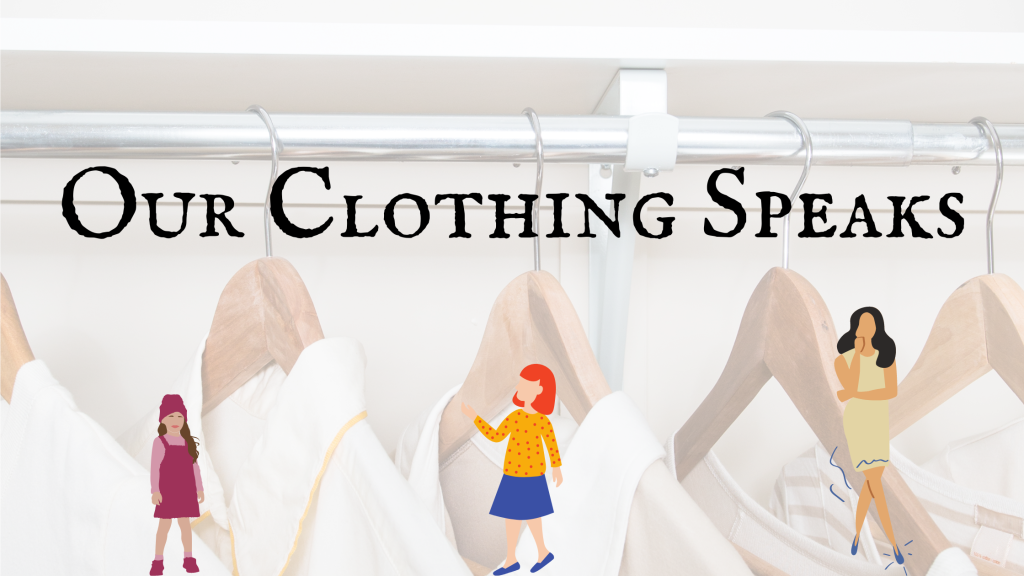I recently purged my wardrobe. I went through each and every item and decided what to keep, what to trash, what to donate, and what to give away. My body has changed quite a bit in the last two years. From pregnancy to postpartum, my wardrobe has had to adjust with my ever changing body and season of life. I find myself now looking for very specific things when I am making clothing purchases.
- It has to be modest
- It has to be breastfeeding friendly
- It has to be made of natural fibers
I also am constantly thinking about what kind of message am I silently conveying with what I wear?
Whether we like to admit it or not, our clothing speaks. Our clothing sends messages to others about how we desire to be perceived.
It is true that we cannot control the thoughts and actions of others based on how we dress; and we should never be blamed for the actions of others based on what we happen to be wearing; but we would be foolish to be willfully ignorant of the fact that clothing conveys messaging. Over this, we have full control.
I think about clothing’s messaging not only when it comes to what I personally wear, but what my son wears as well. Now that I am a parent, I have become acutely aware of the fact that there are individuals who might wish to harm my child. I also am now highly in-tune to how children’s clothing sets children up for society’s expectations of them.
Children’s clothing is constantly plastered with tongue in cheek phrases that are meant to make us adults chuckle. Yet, if we really think about these tongue in cheek phrases, it should leave us scratching our heads. It would be easy to say: “Oh well, they’re kids, they don’t understand what that means.” But just like how over time, slow dripping water will erode steel, eventually these tongue in cheek phrases will be internalized and understood.
We are living in an unprecedented time in which it seems like children are growing up faster. They’re being exposed to things at younger and younger ages, and this is having a noticeable impact.
Just this weekend I stumbled upon a TikTok video in which a teacher was showing off her class and what they were wearing to a fifth grade graduation.
Fifth grade.
All except four of the young ladies were wearing short, body con, revealing dresses with high heels. The young men were dressed in very form fitting pants, and layered tops that were reminiscent of an exact outfit I’ve seen grown men wear, and they were holding up known gang signs.
Is there anything wrong with short dresses? No
Is there anything wrong with body con dresses? No
Is there anything wrong with high heels? No
Is there anything wrong with wearing a “mini me” version of a grown up’s outfit? Not necessarily, but it’s important to be careful to keep the outfit age appropriate.
Age appropriate. That is what I want to focus on.
It’s only natural that as children grow, they want to experiment with style and fashion, but we as adults need to be fully aware of the fact that there is messaging behind certain styles and garments.
Why do we as adults wear what we wear?
Take a body con dress for example, much like the one shown below:

This dress…. is sexy. Point blank. It shows off a large amount of skin, it hugs the figure, it’s made of a silky or satin like material, and it’s red. Silk, satin, and the color red all have a long history with being tied to sensuality.
Is this woman looking for attention in this dress? That is not for us to decide, only for her. But we can all agree that she looks good. The messaging behind this dress is sensuality. This dress is meant to be worn in adult settings and to be noticed by adults.
So it would only be logical to conclude that a dress like this would not be age appropriate for a child. Yet it was this kind of dress that I saw those children wearing.
Like stringing words together to form a sentence to convey a verbal message, so does combining colors, fabrics, and cuts of clothing to convey an unspoken message.
Many people say to themselves: “Well they’re just kids, they’re having fun, you’re a weirdo if you’re tying anything inappropriate to what they’re wearing.”
It is our job as parents and adults to protect our children from harm. If a garment would send a particular message about the wearer if an adult wore it, why does a child need to wear it?
If a garment conveys messaging that would be inappropriate to say to a coworker, why is it ok for it to be plastered on a 2T t-shirt?

The clothes we choose to wear can be powerful. It’s why we see such thought and effort go into the wardrobes of the likes of Catherine Middleton, Princess of Wales, and Politicians around the world. Our Clothing Speaks, and we want to make sure that we aren’t sending out the wrong message about ourselves or even our children.
Xoxo,
Victoria
